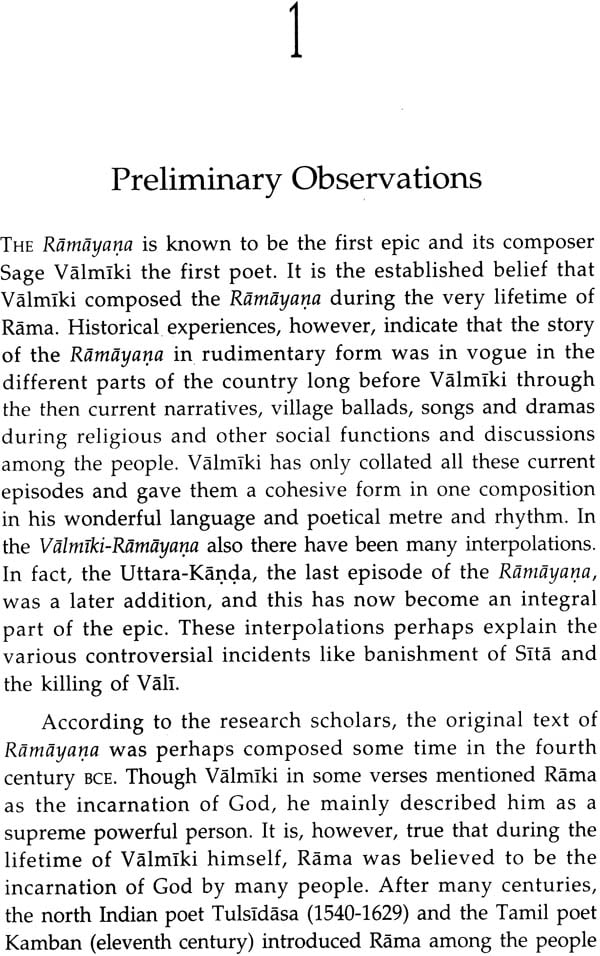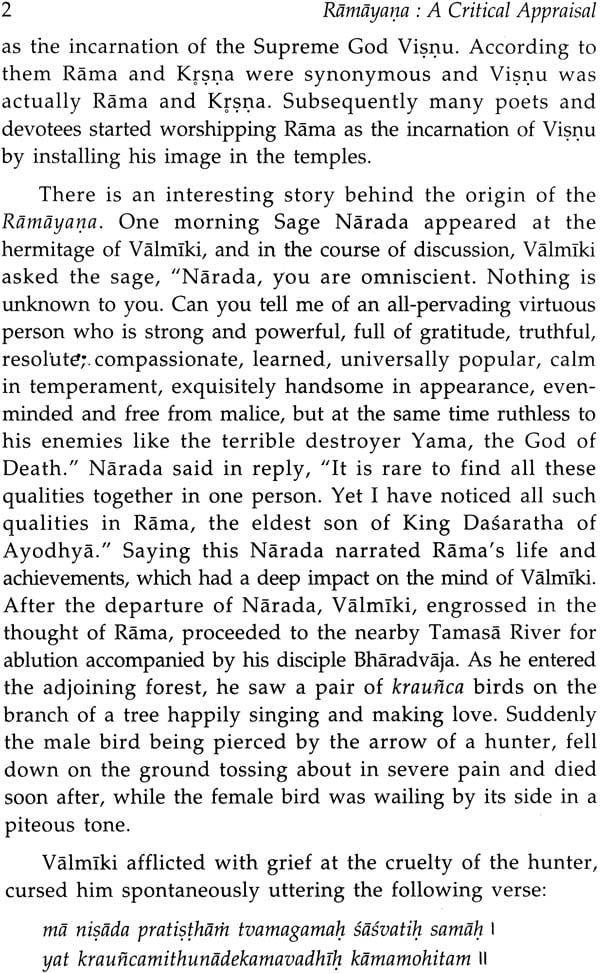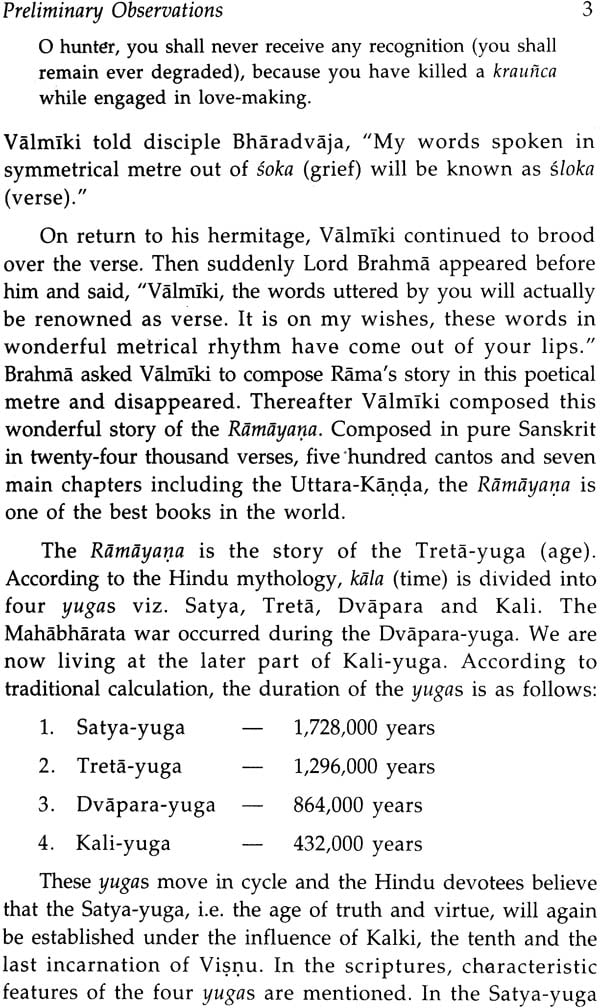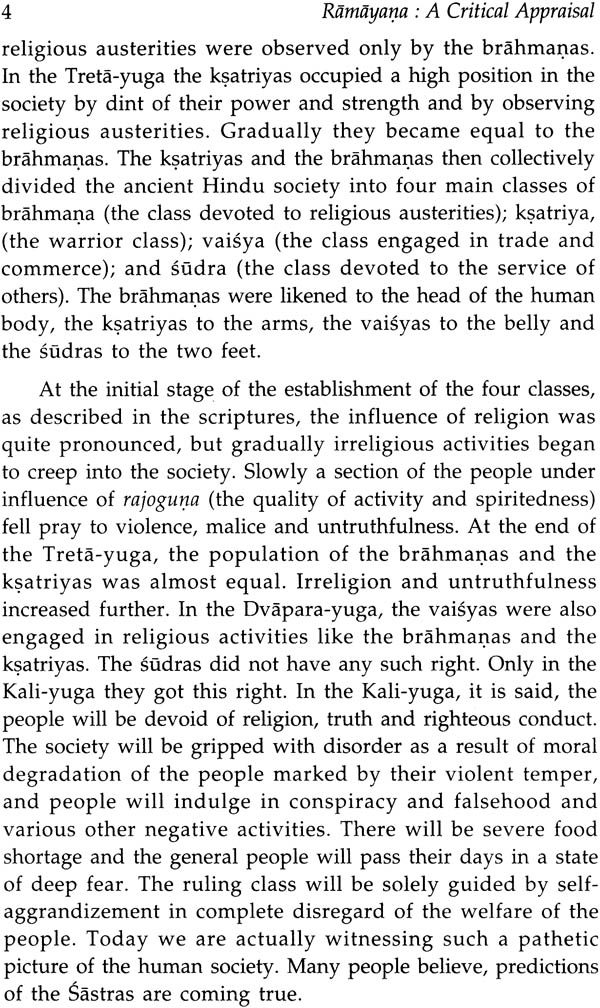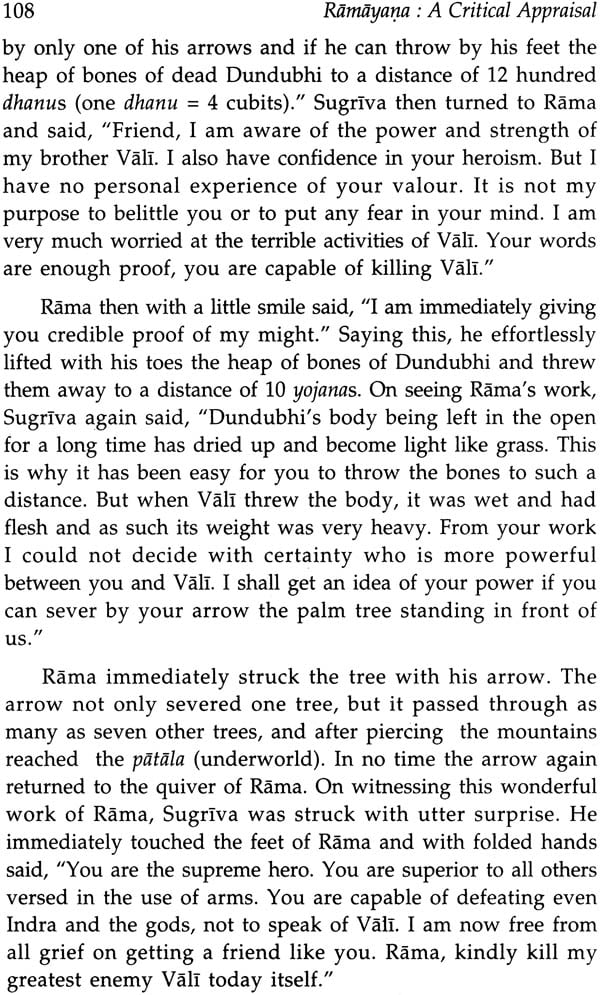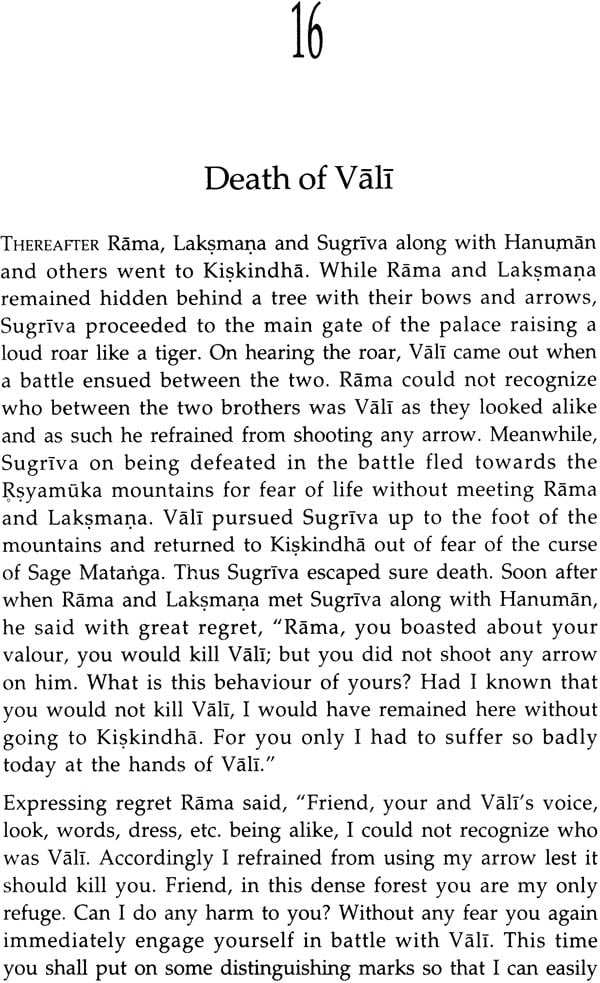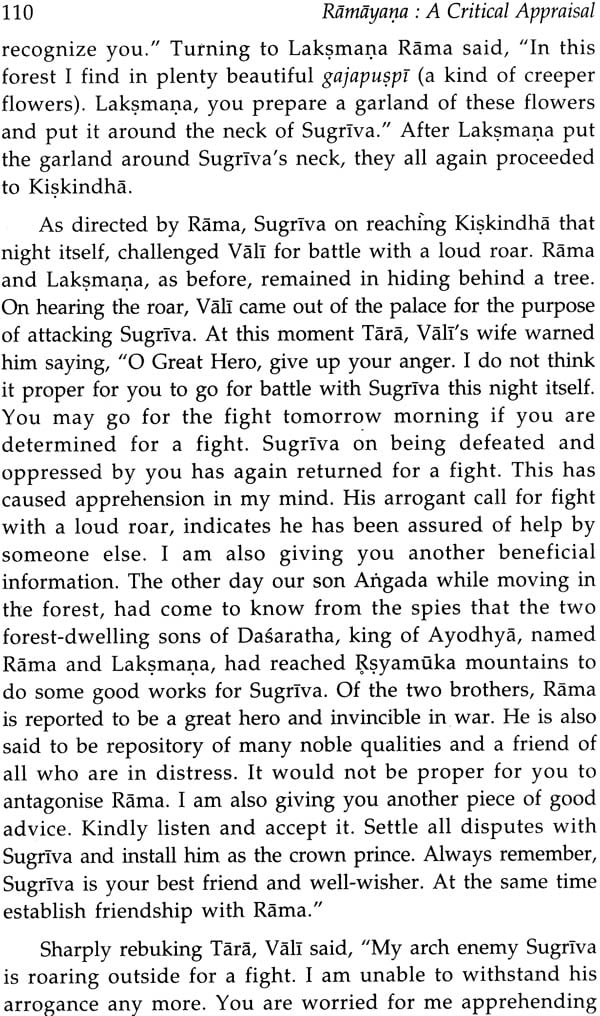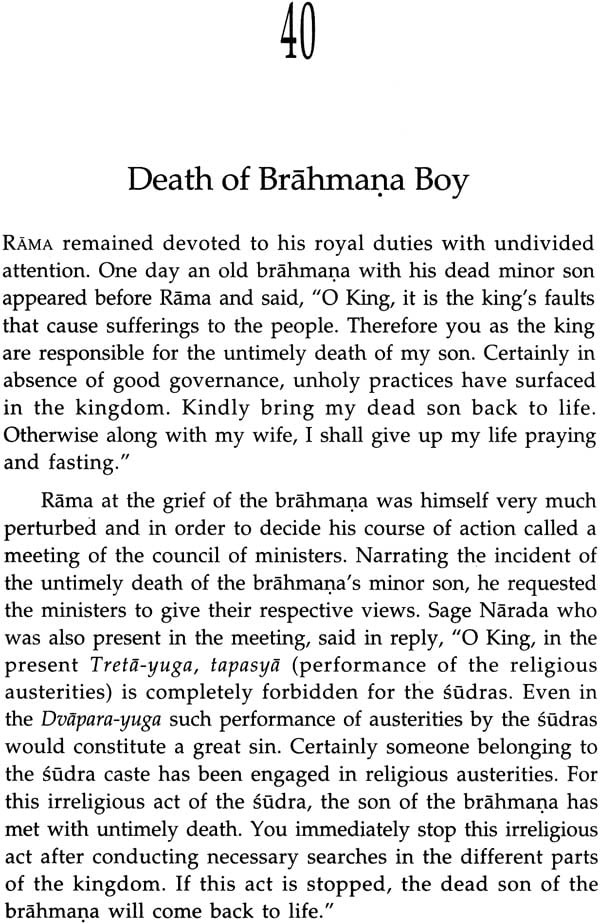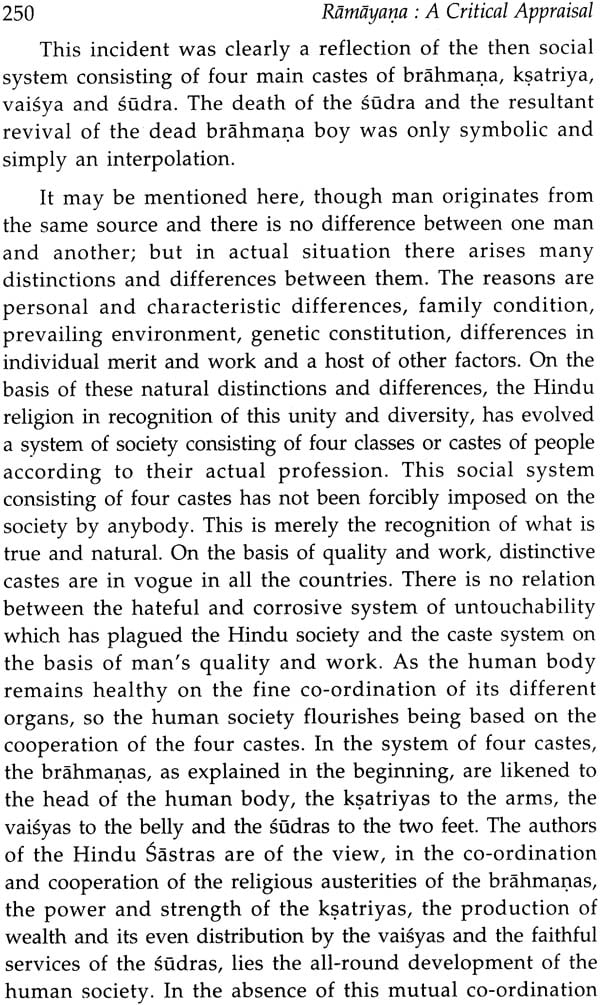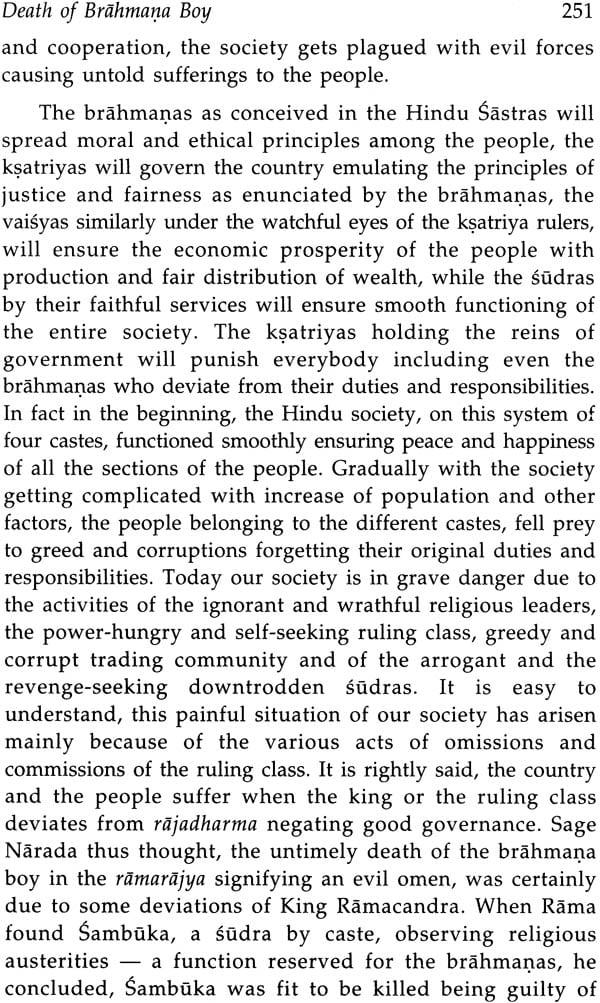
Ramayana – A Critical Appraisal
Book Specification
| Item Code: | IHL219 |
| Author: | Ramendra Narayan Sanyal |
| Publisher: | D. K. Printworld Pvt. Ltd. |
| Language: | English |
| Edition: | 2010 |
| ISBN: | 9788124605516 |
| Pages: | 288 |
| Cover: | Hardcover |
| Other Details | 9.0 Inch X 6.0 Inch |
| Weight | 520 gm |
Book Description
Based on the Valmiki Ramayana, this book discusses the major events of the Ramayana including those in the Uttarakanda, analyzing and interpreting them with a fresh approach. Written in a simple and lucid style, the work deals with the birth of Rama, his destruction of raksasas accompanied by his brother Laksmana, of Dasaratha, Rama’s exile, the many developments that led to the war between Rama and Ravana and the later events like Rama’s coronation, his abandonment of Sita and the last journey of Lord Rama. It brings out the many qualities of Rama like virtuousness, courage, compassion, equanimity of mind, devotion to duty and truth, and selflessness that make Rama a glorious, divine figure and the story in the Ramayana an unparalleled epic of the world. It also discusses the controversial acts of Rama like his killing of Vali and humiliation of Sita after her rescue. It underlines the importance of the example of Rama and the teachings of the Ramayana in the contemporary world.
The volume will fascinate a range of readers – general readers as well as scholars of Indian religion and culture who want to gain a fresh perspective on the glorious Ramayana tradition.
Ramendra Narayan Sanyal (b. 1926) began his professional career in a college after successfully completing his Masters in Economics from Calcutta University. Later he went on to compete in the State Civil Services examination that led him to begin a long association with the West Bengal State Police Service and then with the Intelligence Bureau, Government of India. Over the course of nearly three decades he served in various capacities handling many sensitive assignments of national and international importance. Awarded the Indian Police Medal for Meritorious Service, Police Medal for Meritorious Service and the Police (Special Duty) Medal, Manipur. Since his retirement, he has been a prolific writer on diverse subjects including a recently published in –depth analysis of the intelligence network in the Mahabharata and its relevance in the present geopolitical risks that India faces.
My first book in Bengali entitled Mahabharate Goenda (Intelligence operators in Mahabharata) received wide appreciation from the readers, many of whom requested me to compose a similar book on the other Indian epic Ramayana. Accordingly I have prepared a book in Bengali on the Ramayana on similar lines. For the benefit of the English speaking people, this English version of the book has been prepared. The book is a critical appraisal of the events in the Ramayana as also of its principal characters particularly Rama and Ravana with special emphasis on intelligence collection, rajadharma and the relevancy of the teachings of Rama and the Ramayana in our present society.
Rama got all information about Sit and Ravana on her abduction by the latter from some of his well – wishers like Jatayu and raksasa Kabandha in the course of his search for her in the forest along with brother Laksmana. On Kabandha’s advice Rama entered into an alliance with vanara hero Sugriva and this alliance in fact set in force all efforts for the search and rescue of Sita. Rama killed Vali, Sugriva’s elder brother who had driven him away from the kingdom, and installed Sugriva on the throne. That Sita had been held in captivity by Ravana in Lanka was also known from Sampati, Jatayu’s brother, by the group of vanara leaders who were deputed by Sugriva to the south for the search of Sita. In this group was Hanuman, Sugriva’s prime minister. He was a learned person possessing supernatural power on the strength of boons bestowed on him by Lord Brahma and other gods.
Hanuman on reaching the seashore along with his group climbed the nearby Mahendra hills and assuming a huge form rose to the sky reaching Lanka by the aerial path after crossing the vast sea. In the course of search in Lana after assuming a diminutive form, he ultimately found Sita at Ravana’s Asoka garden and met and talked with her after proving his credentials. He, thereafter, again assumed a huge form and destroyed the ramparts and some of the place buildings. He even killed the raksasa army deputed against him. Later he set the city on fire causing considerable damage. In course of his activities Hanuman collected useful information on Lanka’s defences, strength of the raksasa army, its deployment, war tactics and strategies, weaponry, etc. Vibhisana, Ravana’s brother who sided with Rama, was the repository of many vital secrets about war tactics of the raksasa warriors. In fact Indrajit, the valiant son of Ravana was killed by Laksmana on the basis of information furnished by Vibhisana.
Rama thus had all the information about the enemy though he had no organized intelligence set – up of his own. Hanuman and Vibhisana were his principal intelligence operators. The royal army of Ayodhya and its secret agents had no role to play in the war.
Ravana had a strong band of trained secret agents from whom he obtained detailed information about the advancing vanara army. Suka and Sarana were Ravana’s principal intelligence operators. In the Ramayana we find, vanara king Vali had also under him a band of efficient intelligence agents. His son Angada collected from them advance information about the alliance between Rama and Sugriva. It was indeed a very difficult intelligence operation as the mountains where Sugriva lived with his companions ere out of bounds of Vali and his men because of the curse of Sage Matanga.
In the matter of intelligence gathering about each other’s army, both Rama and Ravana were equally matched. In valour and strength the principal warriors of the rival armies were equally competent. They were all armed with various divine weapons. In the terrible battle between Rama and Ravana, victory or defeat remained undecided for a long time. It appeared, Rama and Ravana were invincible to each other. Even the gods at one time declared both Rama and Ravana as jointly victorious. At last Rama killed Ravana with the brahmastra sent by Devaraja Indra, his own weapons having failed to do the needful. Ravana’s death at the hands of the Rama was a divine inevitability. With Ravana’s death, the purpose of birth of Rama on earth as the incarnation of Supreme God Visnu to desteroy the sinful Ravana, was fulfilled. The good ultimately triumphed over the evil.
On ascending the throne of Ayodhya, Rama established a righteous rule faithfully adhering to the principles of rajadharma whrere the people lived in peace, happiness and prosperity. In his Ramarajya there was no widowhood. Everybody lived a long and healthy life. The rainfall was plenty and the agricultural fields grew food grains in abundance. The people lived a virtuous life. The governance was strong and impartial. With strict enforcement of the laws, the good remained ever protected, while the bad were punished with an iron hand. Mahatma Gandhi, father of the nation enamoured of Rama’s Ramarajya, wanted to establish in India such a righteous society. Though such an ideal state is practically inconceivable, there is no gainsaying the fact that if the kings or the rulers imbued with the lofty principles of rajadharma as enshrined in the Ramayana run the administration impartially and honestly, substantial improvement can be brought about in the society ensuring the well – being of the people.
Despite his controversial acts like killing of Vali stealthily when he was engaged in combat with hi brother Sugriva, humiliation and ordeal of fire of Sita at Lanka on her rescue, abandonment of Sambuka, a low caste sudra for observing religious austerities, etc. Rama is held in high esteem and devotion by the countless people for his nobility of character, achievements and establishment of a righteous society ensuring for all peace, prosperity and happiness. The religion, culture, custom and traditions, thinking and belief and in fact the very existence of the vast sections of the Hindus, centre around the teachings of Rama and the Ramayana. We hope and pray for the advent of leaders like Rama to establish in the coming days a righteous and peaceful society in our country for the good of all.
I have composed my book on the basis of the events as described in the Valmiki – Ramayana. For this I have mainly followed the faithful Bengali translation of the original Ramayana by Sri Tarakanta Devasarma published by M/s K.P. Bagchi & Company Private Limited, Kolkata. Other helping books, I have consulted are Ramayana by C. Rajagopalachari, The Ramayana by R.K. Narayan, Sri Ramacaritamanasa by Hindi poet Tulsidasa. The Ramayana by Bengali poet Krttivas, The Valmiki – Ramayana by the famous Bengali writer Rajsekhar Basu and The Ramayan Katha by Bengali writer Rajsekhar Basu and The Ramayana Katha by Bengali writer Amalesh Bhattacharya. I have also consulted various books on Vyasadeva’s Mahabharata from which I have given some relevant references in my book. From the websites and the various journals and papers I have also collected some relevant materials for the book. All comments, analyses, assessments and interpretations are, however, exclusively mine.
My wife Smt. Krishna Sanyal, my daughter Smt. Sanjukta Maitra and my daughter – in – law Smt. Devolina Sanyal helped me in various ways in the writing of the book. I convey my grateful thanks to them. I also thank my friends and well wishers for their valuable suggestions which proved very helpful to me. I regret, I could not mention their names individually.
Written in simple and lucid language with a new outlook, the book containing all the major events of the Ramayana including those in the Uttara – Kanda with detailed analyses and interpretations, will no doubt be found interesting to the reading public.
155
| Preface | vii | |
| 1. | Preliminary Observations | 1 |
| 2. | Birth of Rama | 5 |
| 3. | Rama with Brother Laksmana Accompanies Sage Visvamitra to Janasthana and Destroys the Raksasas | 9 |
| 4. | Descent of Ganga on Earth | 18 |
| 5. | Fight for the Nectar of the Sea between Devatas and Daitya - Danavas | 21 |
| 6. | Rama Breaks Haradhanu and Wins Sita | 25 |
| 7. | Rama’s Exile to the Forest | 31 |
| 8. | Death of Son of Blind Sage and Death of Dasaratha | 49 |
| 9. | Analysis of Rama’s Exile | 51 |
| 10. | Rama Settle in the forest and Bharata’s Efforts to bring Him Back | 56 |
| 11. | Humiliation of Surpanakha | 73 |
| 12. | Surpanakha’s Exposition of Spy – policy and Rajadharma before Ravana | 78 |
| 13. | Abduction of Sita by Ravana | 83 |
| 14. | Search for Sita in the Forest | 95 |
| 15. | Alliance of Rama with Sugriva | 102 |
| 16. | Death of Vali | 109 |
| 17. | Rama deputes Laksmana to Kiskindha to Remind Sugriva to start Search for Sita | 125 |
| 18. | Sugriva’s Vanara Soldiers Begin the Search | 131 |
| 19. | Hanuman Crosses the Sea and Meets with Sita in Lanka | 137 |
| 20. | Valiant Deeds of Hanuman in Lanka and Collection of Vital Intelligence about Raksasa Army | 147 |
| 21. | Rama’s Lanka Campaign | |
| 22. | Ravana Reviews Was Situation and his Differences with Vibhisana and Kumbhakarma | 158 |
| 23. | Vibhisana’s Surrender before Rama | 162 |
| 24. | Collection of Intelligence by Raksasa Spies | 169 |
| 25. | Vanara Soldiers build Bridge across Sea | 171 |
| 26. | Spy Suka Reports to Ravana | 173 |
| 27. | Ravana Deputes More Spies to Collect Information about Vanara Army | 174 |
| 28. | Ravana Devises a Novel Plan to Win over Sita | 180 |
| 29. | Ravana Rejects Last – Minute Advice of his Well – wishers to have Peace with Rama | 182 |
| 30. | Battle between Raksasa and Vanara Armies | 184 |
| 31. | Death of Kumbhakarna | 188 |
| 32. | Death of Indrajit | 199 |
| 33. | Death of Ravana | 208 |
| 34. | Sita’s Ordeal by Fire | 223 |
| 35. | Rama Leaves Lanka for Ayodhya | 231 |
| 36. | Rama’s Inhuman Behaviour with Sita on her Rescue – Some Observations | 233 |
| 37. | Rama Arrives at Nandigrama and Meets with Bharata | 236 |
| 38. | Rama’s Coronation and his Establishment of a Righteous Society | 239 |
| 39. | Abandonment of Sita | 242 |
| 40. | Death of Brahmana Boy | 248 |
| 41 | Sita’s Entry into Patala | 253 |
| 42. | The Last Journey | 257 |
| Conclusion | 262 | |
| Index | 268 |
